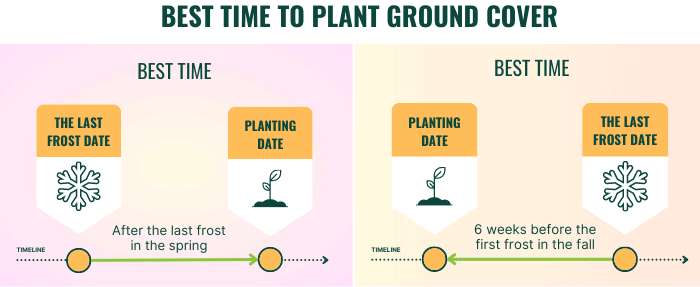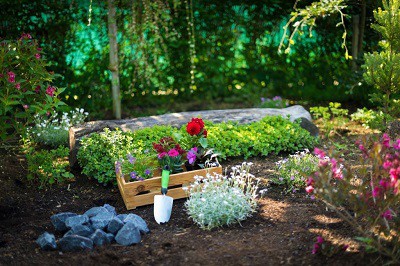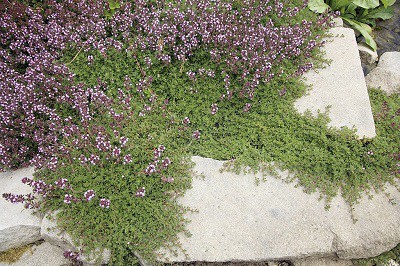Grass can enhance the aesthetics and commercial value of a property and is often seen as a symbol of the quintessential American home. However, you may find the look of grass lawns uninspiring and want something more colorful as an alternative.
In that case, learning when to plant ground cover is a good idea. The term “ground cover” refers to a group of plants that spread low on the ground and come in various hues and shapes; examples include lilyturf, purslane, and Phlox.
It’s best to plant these in the spring and fall when there’s no frost, though the specific months can vary depending on the species you choose.
Table of Contents
Best Time to Plant Ground Cover
When it comes to backyard ground cover, the general planting time is after the last frost in the spring and six weeks before the first frost in the fall.
Summer gardening may be possible in certain cases, but you’ll need to irrigate the plants more often due to the excess heat of the season.
With that said, below are some popular ground cover species you can try and their gardening time. We recommend picking a flora that suits your hardiness zone, one that is not on your state’s list of invasive species—English ivy and vinca are considered invasive in Maryland, for example.
It’s also beneficial to consider other practical requirements like maintenance, whether the plant can withstand shade, and how fast it grows.
| Category | Species | Hardiness zones | Planting time |
| Low-maintenance ground cover plants | Lady’s mantle | 3 to 8 | After the last frost, six weeks before the first frost |
| Creeping Phlox | 5 to 8 | After the last frost if direct-sown, or grow in containers six weeks before the final frost and move the seedlings outside after it | |
| Lilyturf | 5 to 10 | After the last frost in spring or during summer when the weather isn’t hot.
Zone 8 and higher can grow lilyturf in the fall from October to December. |
|
| Honeysuckle | 4 to 9 | After the last frost in spring up to early summer. Six weeks before the first frost in the fall. | |
| Fast growing ground cover plants | Bugleweed | 4 to 10 | Indoors six to eight weeks before the last frost. Transplant outside once the frost is gone. |
| Rockcress | 6 to 8 | Plant indoors four to six weeks before the final frost or direct-sow outdoors after said date, around February to June and September to October. | |
| Sedum | 4 to 9 | After the last frost; six weeks before the first frost | |
| Dirt ground cover for shade under trees | Strawberry begonia | 7 to 9 | After the last frost |
| Hardy plumbago | 5 to 9 | After the last frost | |
| Sweet woodruff | 4 to 8 | Direct-sow after frost has disappeared in spring or start seeds indoors ten weeks before the final frost. | |
| Ground cover for slopes | Creeping juniper | 3 to 9 | Early spring to late fall when there’s no frost, but not in the summer |
| Creeping thyme | 2 to 9 | Eight to ten weeks before the final frost for indoor sowing. Transplant or direct-sow outdoors after frost has vanished. | |
| Mondo grass | 5 to 10 | Spring and fall (but will grow over landscape pretty much all year) |
Tips for Growing Ground Cover Successfully
After you decide which ground cover to plant in fall and spring, follow the tips below to grow it well.
1. Prepare the planting location
Remove all weeds with a herbicide, then till an all-purpose, slow-release fertilizer and two to three inches of compost into the soil.
Check the pH and sun requirements of the ground cover you intend to grow, then use wood ash, sulfur, or whatever your soil test recommends to adjust its acidity when necessary.
One thing, though—do not till slopes or hillsides, as this act can encourage erosion. Just plant the ground cover once you’re done with the other steps.
2. Space plants according to their widths
If you use ground cover plants instead of grass to prevent weeds, it’s essential to space the plants out based on their spread at maturity. This will ensure maximum coverage without bare, patchy spots for weeds to creep in.
Creeping thyme can reach 12 inches wide, for example, so thyme transplants from a flat will do well if they have 12 inches of clearance.
Just make sure to dig a hole as deep as and slightly bigger than the roots, then put the ground cover into the soil without submerging the plant’s crown.
Feel free to adjust the ground cover spacing as well and change the holes’ locations before backfilling them. You’ll want to make sure the garden looks as similar to your design as possible.
3. Water and mulch the soil
To grow ground cover successfully, irrigate the soil twice a month with no more than one gallon of water per square foot in total (use half of this amount each time). We also recommend applying two inches of mulch to deter weeds and prevent drought.
Conclusion
Ground cover grasses have their benefits and appeals. However, in terms of shade tolerance and fertilizer requirements, perennial shrubs and vines clearly have them beaten, as these plants can grow under trees well and require little maintenance.
We hope this article showed you when to plant ground cover and renovate your lawn. Have fun gardening!
Read next:

Hi, I am William – Floridayards’ digital content creator. My job is to find answers to all your concerns with thorough research and our team’s expert advice. I will also bring you honest reviews on the best products and equipment for raising your beautiful garden. Please look forward to our work!















